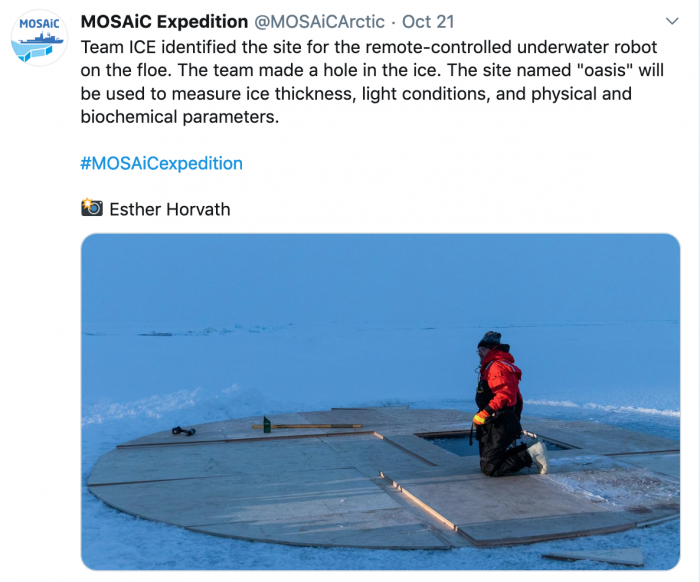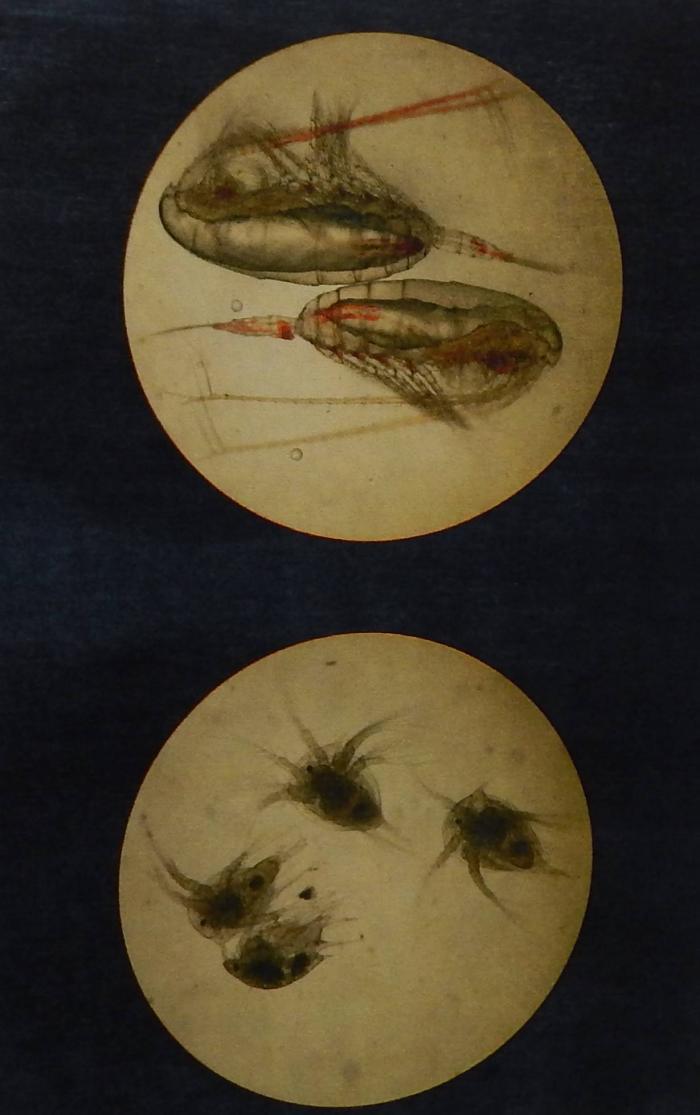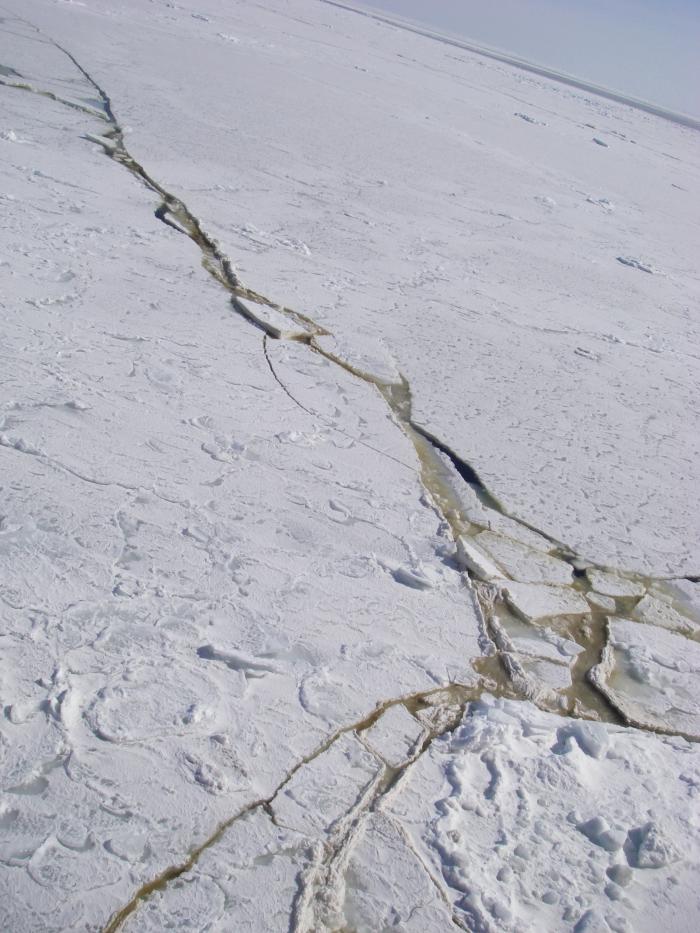Life in the Ice
Imagine living in a place where your home was shrinking for more than half the year, the walls literally closing in on you. For organisms living in Arctic sea ice, this is just one of the many challenges they have to handle in order to survive. However, a diverse community of organisms have adapted to this strange and challenging home inside the ice.

Look closely at sea ice, and you might see a mixture of copepods, rotifers, nematodes, ciliates, flagellates, amoebae, diatoms and bacteria. This is their home. Amphipods and copepods are both types of crustaceans; if you haven't seen them before, think of small shrimp and you have the general idea. CopepodsCopepods are a type of small aquatic zooplankton found in either fresh or salt water. To see pictures of Calanus hyperboreus, Calanus glacialis, Calanus finmarchicus, and other zooplankton click here. tend to be tiny enough to actually live within some of the larger channels in the ice. Amphipods are a bit bigger. They can't get into the middle of the ice, but ice-endemic amphipods can be found at the bottom of the sea ice. They crawl along the underside of the ice to eat the organisms that live there. These amphipods live at the ocean bottom when they are young. As they grow into adults, they swim in search of suitable spots on the underside of the sea ice and make that their new home.

The structure of sea ice is different than the structure of freshwater ice. As the sea water freezes, salt is pushed out of the ice. Some of the salt is rejected through the top or bottom of the sea ice. Some of the salt gets pushed into pockets between the ice crystals that are forming and growing. This forms brine channels of extra salty water. As temperatures continue to drop, some of the water in the brine channels will freeze even though it is salty. Then ice grows into the brine channel, shrinking the diameter of the channel.
This means that some organisms simply can't fit into the smallest brine channels and have to retreat to areas with larger diameters. Being able to squeeze into narrow brine channels is an advantage though; organisms are protected from larger predators there and don't have to compete as much for space and nutrients. To allow for this, many sea ice organisms have flexible or elongated bodies. For example, one study found that a type of organism called turbellaria can reduce their body diameter by 70% to fit into smaller channels!
Shrinking brine channel diameter isn't the only change that happens over the course of sea ice formation. As water in the brine channels continues to freeze, the liquid brine leftover becomes extra extra salty. The volume of liquid water has decreased but the volume of salt stays constant. Sometimes the salinity of this brine can be as high as 100 parts per thousand. This is about 3 times more salt than what is typically found in ocean water.
How do organisms survive this super salty situation? For microbes like bacteria and ice algae living within the brine channels, only a thin cell membrane separates their internal structures from the outside watery world. In these super salty conditions, they risk losing fresh water and becoming filled with brine. To prevent this, many alga produce osmolytes. These osmolytes are compounds that mimic a higher salinity. They artificially increase the internal salinity of the algae. Now, salt won't flood into the cell because it is filled with 'salt-like' osmolytes.
Many osmolytes also serve as a sort of anti-freeze. They prevent ice crystals from forming. This helps organisms living in sea ice to survive very cold temperatures. One of these anti-freeze compounds is called homarine. It was first discovered in lobsters! In fact, the word homarine comes from the lobster genus name of Homarus. Many organisms in and around the sea ice utilize homarine and other compounds to survive the cold temperatures. Without this anti-freeze, the cells would burst as they freeze.
There is another risk from the cold. Every living thing depends on enzymes to function. Enzymes are chains of amino acids with differently charged parts. These charges cause the enzyme to fold and unfold in particular ways. But each enzyme works at only a specific temperature range. If it is hotter than this temperature range, the enzyme becomes denatured. The enzyme flattens out and stops working. On the other hand, at colder temperatures most enzyme activity slows down. Arctic species use enzymes that function best at cold temperatures.
For organisms that photosynthesize (create their own sugar using water, carbon dioxide, and energy from the sun), polar night presents a major obstacle. They have to be able to photosynthesize with only very low levels of light. At noon on a clear day near the equator, lots of light hits the earth's surface. The number is about 1,500-2,000 micromoles of photons per square meter every second. By comparison, the Arctic in early winter sees only about 5-25 photons per square meter every second. This amount shrinks even more in the middle of polar night.
This light limitation would represent a very significant problem for most photosynthesizers. However, ice algae (and arctic phytoplankton) are well-adapted to deal with this. They use pigments for photosynthesis that are able to be efficient at even low light levels. Sea iceThere are terms for different types of ice. Shorefast ice forms along coasts and is attached to land. Pack ice is ice floating in open water. Multiyear ice is ice that has survived at least 1 summer. First year ice is ice that has not yet survived a melting season. algae and arctic phytoplankton keep their chloroplasts and pigments intact through the winter. This allows them to take advantage of the first increases of light in the spring. During times of higher light intensity, many types of ice algae convert sugars into fats and store them as lipids. During the winter, they can use these lipids as an energy source. Other photosynthesizers are actually mixotrophs. This means they have mixed food sources: sometimes they make their own sugars through photosynthesis and sometimes they feed on other organisms. These mixotrophs likely photosynthesize when light conditions are favorable and turn to alternative food sources during the winter.
However, the problem is not just low-light conditions. During the summer months, ice algae can experience very high light levels. These extreme conditions are a problem. Since the algae have to be sensitive to low-light conditions in the winter, they run the risk of damage to pigments, enzymes, and the overall cell if they are exposed to too much sunlight in the summer. Many algae produce special pigments that serve sort of like sunblock. These pigments absorb some sunlight and shift it out of the photosynthesizing chain. Algae can also acclimate to lower or higher light levels by changing the number of photosynthetic chains that they use. In low light conditions, they'll use fewer chains. In higher light conditions, they'll use more to minimize the chance that any single chain will be overwhelmed by too much energy.

It is truly amazing to me that such a diversity of organisms have adapted to thrive in the extreme and unique environment of sea ice. Over 1000 species of algae (both sea ice algae and phytoplankton) have been found in the Arctic! There is lots of variation in sea ice community composition. No two sea ice communities are exactly the same. The species living in any one section of sea ice will likely be different than the community in other sea ice. What you find in the sea ice depends on the physical characteristics of the sea ice like how big the brine channels are and how connected they are. It depends on how old the sea ice is. It depends on where the sea ice formed and which organisms where initially frozen in from the sea water. It depends on how nutrients, oxygen, and carbon bubble move through the brine channels and become concentrated or depleted over time. It also depends on where the sea ice has drifted and which 'hitchhikers' it has picked up along the way. It depends on whether the sea ice is covered by snow, as this blocks light from reaching photosynthetic organisms in the brine channels, and how deep and consistent the snow cover is. And the community changes over time as things eat each other and die and reproduce and use up nutrients and get squeezed out of shrinking brine channels. Researchers don't yet know how all these factors come together to define a community of organisms within sea ice. What a fun and fascinating thing to study!
Education Extension
EcoChains is a really fun card game that explores ice-dependent and ocean food chains in the Arctic Ocean. I've played it with adults and with a six year old. With the six year old, the images of the organisms and the information about them was interesting and she enjoyed creating food webs. Game play itself was a litte beyond her level of comprehension and patience. I think it would be great for upper elementary age range, but could also be fun for older learners. Check out the EcoChains website for more information. The card decks are not free, but they do have deals for educators.
The idea of shrinking brine channels and extreme conditions brings to mind some great team-building activities. Unfortunately, I don't have directions for any of them with me. With team-building activities, it is important to have a clear idea of how to facilitate them to foster the most personal and group growth, so I want to wait to have real resources rather than just sharing a vague outline of what I remember. I will post the instructions here when I return to land. In the meantime, perhaps some of you have suggestions?
For a fun art activity, make a sculpture of sea ice complete with brine channel organisms. I can think of lots of ways to do this, but it seems like a good first step would be to draw, paint, or sculpt a variety of sea ice life. Look at microscope images and photos of organisms that live in sea ice: copepods, turbellaria, nematodes, ciliates, rotifers, flagellates, diatoms, amoebas, and bacteria. Have learners create artistic representations of these organisms. Be sure to spend some time focusing on relevant art learning objectives, like use of contrasting/complementary colors or representing texture. Working across different scales is a great learning opportunity, both in art and science, and math too. Have learners work together to make sure their copepods are appropriately big compared to their diatoms. Provide accurate measurements for the real organisms so they can scale them up in their art.
After the sea ice organisms are complete, you have a multitude of options for your ice structure. I think it would be particularly fun to re-use clear tubing or clear, skinny plastic bottles to represent brine channels of different sizes. Then put the organisms into the tubes and suspend them from the ceiling. Fill in any open areas between the brine channels with gauzy fabric or clear plastic material. Add some amphipods grazing at the bottom of the ice, and even some Arctic cod fish looking to eat the amphipods. You could also do this on a smaller, simpler scale and pack the tubing together into a block on the floor, rather than hanging it from the ceiling. An interesting approach would just be to freeze the organism replicas into a block of ice. If you live in an area with cold winters, you could keep your temporary sculpture outside throughout the winter. Just like much sea ice, the sculpture will probably melt in the spring and the organisms will be flushed out.
A final adaptation that is much more intricate uses glass or ceramic beads. Use thin wire and beads to sculpt sea ice organisms. Once again, you can decide whether to suspend them from the ceiling in a mobile or have your sea ice sculpture rest on the floor. If you suspend them from the ceiling, string clear beads onto thread to create strands of 'ice crystals' that you can also hang from the ceiling around the ice organisms. If you want to have your sculpture rest on the floor, use stiff enough wire that you can create towers of 'ice crystals' with beads coming up from the floor around the sea ice organisms.


Comments